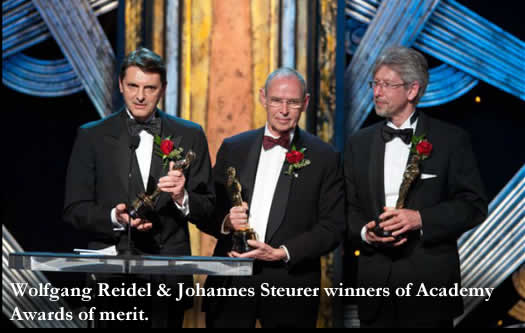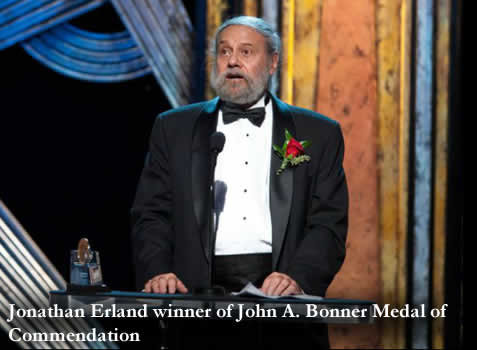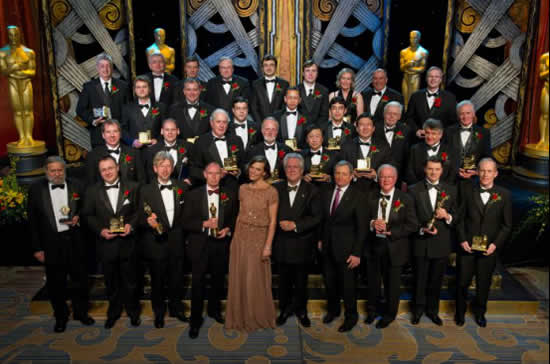 Though less attention is paid to the Scientific and Technical Achievements than the annual Academy Awards, film industry insiders recognize they are important to honor and learn where the next great advances in cinema technology will come from. On Feb. 11, 2012, actress Milla Jovovich emceed at gala at the Beverly Wilshire hotel in Beverly Hills: presenting 10 awards to 30 individuals, including four Oscar statuettes, the first to be handed out in the 2012 Oscar season.
Though less attention is paid to the Scientific and Technical Achievements than the annual Academy Awards, film industry insiders recognize they are important to honor and learn where the next great advances in cinema technology will come from. On Feb. 11, 2012, actress Milla Jovovich emceed at gala at the Beverly Wilshire hotel in Beverly Hills: presenting 10 awards to 30 individuals, including four Oscar statuettes, the first to be handed out in the 2012 Oscar season.
Visionary filmmaker Douglas Trumbull delivered a lengthy, but inspiring acceptance speech, upon receiving an Oscar statuette for the Gordon E. Sawyer Award for his lifetime of technical contributions and leadership in the motion picture industry. Trumbull has distinguished himself as a visual effects pioneer with major contributions to such films as, “2001: A Space Odyssey,” “The Andromeda Strain,” “Silent Running,” “Close Encounters of the Third Kind,” “Star Trek – The Motion Picture,” “Blade Runner” and “Tree of Life.”
He challenged those attending to, “get back to why people go to the movies.” Trumbull continues to innovate with show Scan Digital, a patenting-pending process that uses 24 frames per second while allowing the filmmaker to embed 60 frames per second sequences as desired for creative use.
Visual effects technologist Jonathan Erland followed Trumbull as he accepted the John A. Bonner Medal of Commendation for the distinguished service. Erland said Trumbull  said much of what he planned to talk but imparted, “If our Academy stands for excellence in motion pictures—and it must—then the real task before us is to manage the trends such that motion pictures stay relevant to the Academy’s mission and the ideal we espouse.”
said much of what he planned to talk but imparted, “If our Academy stands for excellence in motion pictures—and it must—then the real task before us is to manage the trends such that motion pictures stay relevant to the Academy’s mission and the ideal we espouse.”
Erland joined Industrial Light & Magic to work on the visual effects for the 1977 film “Star Wars.” He continued in the burgeoning visual effects field as director of research and development for Apogee Productions, where he received patents for a reverse bluescreen traveling matte process, the Blue-Max flux projector and a method for making front projection screens. His innovations previously earned him Academy Scientific and Technical Awards.
Also garnering Oscar statuettes, this time for the Academy Award of Merit, were Franz Kraus, Johannes Steurer and Wolfgang Riedel for the design and development of the ARRILASER Film Recorder. The ARRILASER had been awarded an Academy Plaque in 2001 and was upgraded this year.
The ARRILASER film recorder demonstrates a high level of engineering resulting in a compact, user-friendly, low-maintenance device, while at the same time maintaining outstanding speed, exposure ratings and image quality.
 Andrew Clinton and Mark Elendt received Technical Achievement Awards (and Academy certificate) for the invention and integration of micro-voxels in the Mantra software.
Andrew Clinton and Mark Elendt received Technical Achievement Awards (and Academy certificate) for the invention and integration of micro-voxels in the Mantra software.
This work allowed, for the first time, unified and efficient rendering of volumetric effects such as smoke and clouds, together with other computer graphics objects, in a micro-polygon imaging pipeline.
Scientific and Engineering Awardees Radu Corlan, Andy Jantzen, Petru Pop and Richard Toftness received Academy plaques for the design and engineering of the Phantom family of high-speed cameras for motion picture production.
The Phantom family of high-speed digital cameras, including the Phantom Flex and HD Gold, provide imagery at speeds and efficacy surpassing photochemical technology, while seamlessly intercutting with conventional film production.
Academy plaques went to Michael Lewis, Greg Marsden, Raigo Alas and Michael Vellekoop for the concept, design and implementation of the Pictorvision Eclipse, an electronically stabilized aerial camera platform that allows cinematographers to capture aerial footage at faster flying speeds with aggressive platform maneuvering.
All four recipients were part of the same team who pioneered aerial stabilization for cameras 35 years ago. The system was used on five of last year’s top 10 highest grossing live-action films; “Twilight: Breaking Dawn Pt. 1,” “Fast Five,” “The Hangover Part II,” “Rise of the Planet of the Apes” and “Thor”. Pictorvision president Tom Hallman this design has sped up the process for building environments with animators are using it now to build 3D models.
Scientific and Engineering Awards went to E.F. “Bob” Nettmann for the concept and system architecture, Michael Sayovitz for the electronic packaging and integration, Brad Fritzel for the electronic engineering, and Fred Miller for the mechanical engineering of the Stab-C Classic, Super-G and Stab-C Compact stabilizing heads.
This versatile family of 5-axis camera and lens stabilizers allows any standard motion picture camera to be fitted into the open architecture of the structure. The system can be quickly balanced and made ready for shooting platforms, such as helicopters, boats, camera cars or cranes.
Academy plaques were also awarded to John D. Lowry, Ian Cavén, Ian Godin, Kimball Thurston and Tim Connolly for the development of a unique and efficient system for the reduction of noise and other artifacts, thereby providing high-quality images required by the filmmaking process.
The “Lowry Process” uses advanced GPU-accelerated, motion estimation-based image processing tools to enhance image quality.
Sci Tech Awards committee chair Richard Edlund said the Lowry process, “can make a 2K camera compete with film.” It has been used to digitally lensed features such as, “The Cuprous Case of Benjamin Button,” as well as for restoration and remastering on classics, including, “Snow White and the Seven Dwarfs.”
Lowry did shortly before the awards, on Jan. 21, but had been informed he was a recipient. The Scientific and an Engineering Award was awarded posthumously to Dr. Jürgen Noffke for the optical design of the ARRI Zeiss Master Prime Lenses for motion picture photography. The plaque also went to Uwe Weber for the mechanical design of the Master Primes. Wever was on hand to accept the award for their achievement.
The Master Primes have achieved a full stop advance in speed over existing lenses, while maintaining state-of-the-art optical quality. This lens family was also the first to eliminate the magnification change that accompanied extreme focus shifts.
Rounding out the Scientific and Engineering Awards was a presentation to FUJIFILM Corp., Hideyuki Shirai, Dr. Katsuhisa Oozeki and Hiroshi Hirano for the design and development of the FUJIFILM black and white recording film ETERNA-RDS 4791 for use in the archival preservation of film and digital images.
Specifically designed for laser film recording, the high-resolution FUJIFILM ETERNA-RDS 4791 film stock is an important step in protecting the heritage of the motion picture industry.
Jovovich made her way amply through the difficult terminology and technical descriptions that have often tripped up past presenters. The Ukrainian-born actress, supermodel, fashion designer, singer and public figure, Jovovich starred in such films as, “The Fifth Element” (1997), “Ultraviolet” (2006), and the ‘Resident Evil’ franchise. She stars in the upcoming “Resident Evil: Retribution,” the fifth installment in the sci-fi horror franchise.
Footage of the awards and the winners’ acceptance remarks are available to view at http://www.oscars.org/awards/scitech/2011awards.html.
Portions of the presentation will be included in the Oscar ceremony on Sunday, Feb. 26, at the Kodak Theatre at Hollywood & Highland Center, and televised live by the ABC Television Network. The Oscar presentation also will be televised live in more than 225 countries worldwide.

